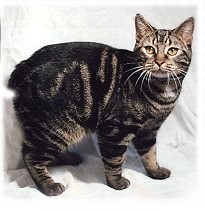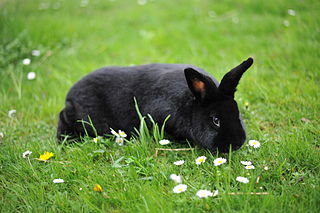
The beagle is a breed of small scent hound, similar in appearance to the much larger foxhound. The beagle was developed primarily for hunting hare, known as beagling. Possessing a great sense of smell and superior tracking instincts, the beagle is the primary breed used as a detection dog for prohibited agricultural imports and foodstuffs in quarantine around the world. The beagle is a popular pet due to its size and good temper.

The Manx cat is a breed of domestic cat originating on the Isle of Man, with a mutation that shortens the tail. Many Manx have a small stub of a tail, but Manx cats are best known as being entirely tailless; this is the most distinguishing characteristic of the breed, along with elongated hind legs and a rounded head. Manx cats come in all coat colours and patterns, though all-white specimens are rare, and the coat range of the original stock was more limited. Long-haired variants are sometimes considered a separate breed, the Cymric.

The Burmese cat is a breed of domestic cat, originating in Burma, believed to have its roots near the Thai-Burma border and developed in the United States and Britain.

The Siberian is a centuries-old landrace of domestic cat in Russia, and recently developed as a formal breed with standards promulgated the world over since the late-1980s. Since 2006, the breed is recognised for registry and championship status with all major cat registries.

The European Shorthair, called the European in FIFe and Celtic/European Shorthair in WCF, is a breed of cat. The term has also been used as an elaborate way of referring to common domestic short-haired cats of Europe, causing some confusion as the pedigree cats of this breed also should resemble the typical domestic cats of Europe.

The British Rabbit Council (BRC) is an organisation for rabbit enthusiasts in the United Kingdom. Rabbits are the UK's third most popular pet.

The Dutch rabbit, historically known as Hollander or Brabander, is a breed of domestic rabbit. It is easily identifiable by its characteristic color pattern and was once the most popular of all rabbit breeds. However, after dwarf rabbits were developed, the popularity of the Dutch rabbit declined. Nevertheless, the Dutch rabbit remains one of the top ten most popular breeds worldwide.
Chinchilla rabbits are a group of three rabbit breeds that have been bred for a coat that resembles that of chinchillas. Despite their name, they are not related to and cannot interbreed with chinchillas, which are a species of rodent. Rabbits are lagomorphs. A mutation diluted the yellow pigment in the hairs to almost white, changing in this way the color of the fur of the wild rabbit (agouti) into chinchilla.

Mini Rex is a breed of domestic rabbit that was created in 1984 in Florida by the late Monna Berryhill of Texas. The Rex mutation, derived in France in the 19th century, is recessive and causes the hair to protrude outwards from the body, instead of lying flat, and the guard hairs to be shortened to the length of the undercoat, or a bit longer.

The French Lop is a breed of domestic rabbit developed in France in the 19th century from the selective breeding of English Lop and Flemish Giant stock. The French Lop resembles the English Lop, but the French Lop is heavier in stature and does not have the exaggerated ear length of the English Lop. Weighing approximately 4.98 kg to 5.21 kg, it has an average lifespan of five to seven years. The French Lop is currently recognized by the American Rabbit Breeders Association (ARBA) and by the British Rabbit Council (BRC).

The term rex rabbit refers informally to one of at least eight breeds of domestic rabbit. One such breed is the Rex, which is recognized by the American Rabbit Breeders Association (ARBA) and by the British Rabbit Council (BRC). Other modern-day rex rabbit breeds are listed below. Care must be taken to distinguish the rex rabbit breeds from the three types of rex rabbit fur for which they are known.

The Argenté rabbit is one of the oldest breeds of French show rabbits. The British Rabbit Council (BRC) recognises six varieties: Argenté Bleu, Argenté Brun, Argenté Crème, Argenté de Champagne, Argenté Noir, and Argenté St Hubert. The American Rabbit Breeders Association (ARBA) recognises the Champagne d'Argent, the Crème d'Argent and the Argenté Brun. A rare variety, the Argenté Clair, is not currently recognised by either the BRC or ARBA.

The Tri-Colour Dutch is a breed of domestic rabbit created in the Netherlands by crossing tortoiseshell Dutch rabbits with Harlequin rabbits. The Tri-Colour Dutch breed is recognized by the British Rabbit Council but not by the American Rabbit Breeders Association. The coat of the Tri-Colour Dutch is white in the same places as a Dutch rabbit, but the coloured portions of the coat are a mix of orange with either black, blue or chocolate.

Miniature Lop is a breed of domestic rabbit recognised by the British Rabbit Council (BRC). Confusion arises because, in the UK, the Miniature Lop is often commonly called the Mini Lop. It is, however, a different breed from the Mini Lop that is recognized by the American Rabbit Breeders Association (ARBA). The BRC-recognized Miniature Lop is most similar to the ARBA-recognized Holland Lop. The Miniature Lop is also similar to several other small rabbit breeds.

Despite its name, the Alaska Rabbit originates in Germany, rather than Alaska. It is a medium-sized rabbit breed, weighing around 7-9 lbs (3–4 kg) with glossy jet-black fur. Any color other than black is a fault for this breed.

The British Giant rabbit is a larger rabbit that has its heritage in the Flemish Giant, a breed that originates in Belgium. The British Giant can grow up to 7 kg and often rivals a small dog in size.

The Miniature Lion Lop is a breed of domestic rabbit recognised by the British Rabbit Council. The breed is not currently recognized by the American Rabbit Breeders Association. In addition to its lop ears, the distinguishing feature of this breed is its Lionhead-type mane and its small size: 1.5–1.6 kilograms (3.3–3.5 lb).















